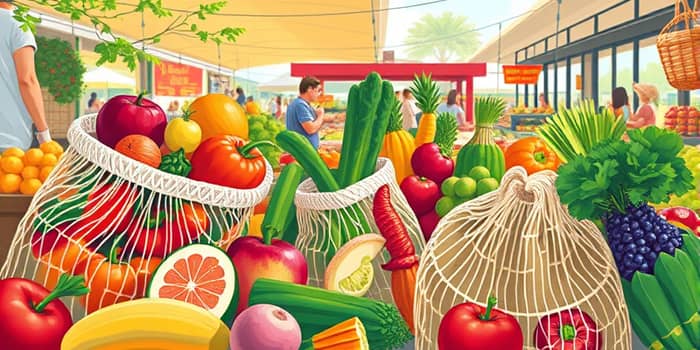Every trip to the grocery store presents consumers with a key decision: to grab a handful of flimsy plastic bags or to invest in stronger, reusable options. With plastic pollution choking landfills and damaging marine life, the call for sustainable alternative to single-use plastic has never been louder. Still, the most eco-friendly bags sometimes tear when the heaviest produce is added, leading to frustration and wasted groceries mid-shop.
In this article, we offer an in-depth guide to high-quality produce bags that endure daily use. We’ll explore the materials and craftsmanship behind the sturdiest designs, share results from rigorous durability tests, and provide practical tips to maintain your bags. Featuring expert recommendations, cost analyses, and environmental insights, you’ll gain all the knowledge needed to make informed, eco-conscious choices at the market.
Why Single-Use Plastic Bags Fall Short
Plastic produce bags are inexpensive and ubiquitous, but at what cost? Every year, consumers use and discard billions of these bags. Estimates suggest that in the U.S. alone, over 100 billion plastic bags enter circulation annually. Many of these end up in oceans and landfills, where they can take up to 500 years to decompose.
Beyond environmental harm, plastic bags offer poor functionality. They tear under weight, allowing kale bunches or potatoes to slip through. Their slippery surface makes packing and carrying a juggling act, while static cling often traps debris. In short, plastic fails on both planetary and practical fronts, prompting a shift toward reusable alternatives that offer double-stitched seams for added strength and reliability.
Materials and Construction: The Foundations of Durability
The backbone of any durable produce bag lies in its material choice and construction quality. Top-rated bags marry robust fabrics with expert stitching to resist tearing, stretching, and fraying—even after months of repeated use.
Common materials include:
- Cotton mesh bags, known for airflow and natural stretch, ideal for veggies prone to moisture buildup.
- Muslin (tightly woven cotton), perfect for tiny items like nuts, grains, and seeds, reducing the risk of spills.
- Synthetic fibers such as nylon or polyester, prized for quick-dry properties and excellent stain resistance.
- Bamboo rayon blends, offering an eco-friendly twist with soft texture and antimicrobial qualities.
Look for features like reinforced drawstrings, reinforced stitching at stress points, and lifetime warranty reflects manufacturer’s confidence. Brands like Purifyou Premium and Lotus Produce Bags use GOTS-certified organic cotton, ensuring ethical sourcing and high tensile strength.
Buying Guide: What to Look For
Selecting the right produce bags involves more than picking a pretty color. Prioritize these factors:
- Weight capacity: Opt for bags rated at least 10 pounds; specialty options can hold over 25 pounds for heavy root vegetables.
- Size variety: Ensure your set includes sizes from small (for berries) to extra-large (for bulk greens).
- Closure systems: Drawstrings, cinch toggles, and secure cord locks prevent spills and make usage seamless.
- Breathability versus protection: Mesh styles excel at air circulation, while muslin keeps fragile items contained.
- Ease of scanning: Semi-transparent meshes speed up checkout, reducing the need to empty bags.
Evaluate price per bag (typically $2–$5 each) against longevity claims and customer reviews. Investing in machine washable and quick to dry bags can save both money and time over the long haul.
Real-World Performance and Testing
Rigorous testing reveals how produce bags handle real grocery challenges. In laboratory conditions, brands are loaded with 5 pounds of potatoes, kale bunches, and mixed fruits to simulate heavy use. The best performers, like Lotus and Seek Bamboo, maintain integrity without seam splitting even when pushed to 125% of their rated capacity.
In-home trials involve hundreds of wash and dry cycles. High-quality cotton blends may shrink slightly but remain functional, while synthetic options spring back to shape immediately. Among top contenders:
- Purifyou Premium Organic Cotton holds over 25 pounds and offers the softest touch on delicate produce.
- Earthwise brand’s premium mesh bags consistently resist staining and dry within minutes in a low-heat dryer.
- Lotus Premium Produce Bags combine mixed fabrics for a versatile multi-purpose solution.
Consumer feedback highlights minimal pilling, sustained color vibrancy, and dependable drawstring closures that don’t loosen under load.
Care and Maintenance Tips
Extending the life of your produce bags is straightforward with proper care. Small habits can prevent premature wear and maintain hygiene:
- Always empty bags of debris and rinse loose particles before washing.
- Pre-treat stains with mild detergent to avoid discoloration.
- Wash similar bags together using a gentle cycle to reduce friction.
- Air dry when possible or tumble dry at low heat to preserve elastic components.
For any minor tears, stitch them promptly using reinforced thread. By following these practices, you’ll experience hundreds of shopping trips and years of use before considering replacements.
Environmental and Cost Benefits
One durable produce bag can offset the use of over a thousand plastic equivalents across its lifespan. For a family of four, this translates to nearly 1,500 fewer single-use bags consumed annually. The environmental payoff includes reduced plastic pollution, lower carbon emissions from manufacturing, and decreased landfill volume.
Economically, spending $30 on a ten-pack of quality bags can save more than $100 worth of plastic bag purchases over a year. Several brands even give back to environmental causes, ensuring your investment supports broader sustainability efforts.
Choosing bags made from recycled materials or certified organic fibers multiplies the positive impact. Moreover, improved produce freshness from breathable mesh that prevents spoilage helps reduce food waste, furthering both ecological and financial benefits.
By adopting reusable produce bags designed for durability, you can stop worrying about mid-shop mishaps and focus on enjoying fresh, healthy groceries. Embrace this simple switch to boost convenience, reduce plastic waste and realize savings over time, and make a lasting contribution to our planet’s well-being.
References
- https://www.americastestkitchen.com/equipment_reviews/2240-reusable-produce-bags
- https://www.theproducenerd.com/2018/11/best-reusable-produce-bags/
- https://www.bulletinbag.com/blog/faqs/reusable-bag-materials-comparison-guide/
- https://ecofreek.com/reusable/reusable-produce-bags/
- https://seekbamboo.com/products/reusable-produce-bag
- https://veggiesaver.com/how-to-use-reusable-produce-bags/
- https://pamelasalzman.substack.com/p/whats-the-deal-with-the-new-plastic
- https://ilovegenerationme.com/reusable-produce-bags










